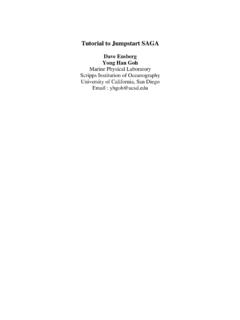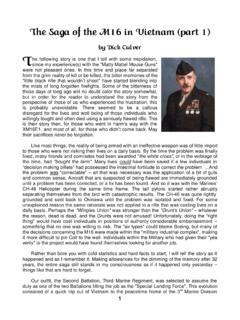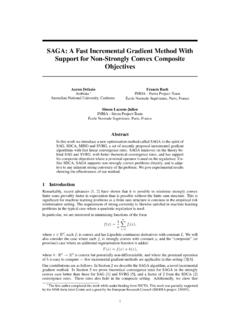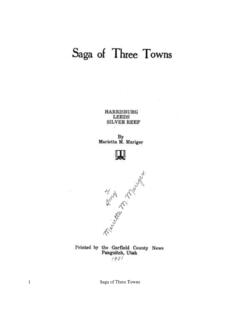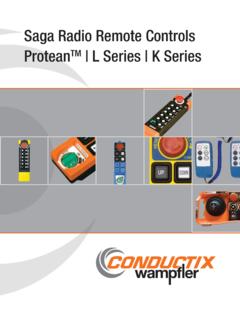Transcription of Saga Rulebook - studio-tomahawk.com
1 1 FAQ saga July 2018 V1 saga Rulebook ClarificationsThe BasicsRE-ROLLSA player can only re-roll his own dice, never those of an opponent. So, any ability that allows you to re-roll dice means that you can re-roll your own dice, never force the opponent to re-roll any of his own dice. An ability that forces an opponent to re-roll dice would explicitly state that. WIDTH OF THE MEASURING STICKSWhen the width of the measuring sticks is important (as it can be the case with some saga abilities), the width is considered as being 1 wide (2,5cm). Movement and chargesMoving figurinesDuring a movement (charge, movement or other) a model is considered as occupying at any time the entire surface of its base. Therefore, it will not be able to pass over an impassable element if part of its movement causes its base to overlap an impassable element. If it becomes necessary to imagine this corridor, draw an imaginary line between each corner of the base of the model, between its starting position and its finishing position.
2 Any area between the two furthest lines is considered to be occupied by the figure during its movement or charge. If any impassable terrain (as enemy figures or another friendly unit) stands in the way, that movement or charge is impossible. During the movement or charge, the figure should freely pivot or change its facing (in the case of models with rectangular or oval bases) but the corridor of movement (or charge) depends of the position and orientation at the start of the movement or charge. It is the player s responsibility to ensure that the unit s cohesion is respected at the end of movement or charge. If the movement or charge has started and it appears that cohesion cannot be respected, the figures return to their initial position, and the movement or charge is cancelled. Players should ensure that the final position of the unit is legal before all figures have been moved. This can generally be checked after the first miniature has been moved.
3 MOVEMENT OF MORE THAN LIf a unit has increased movement beyond L, for example L+S, the rules governing movement are the same as for two rulers. Thus, a unit using two rulers of M and one of C will be able to bend its movement twice: once between each ruler. DECLARATION OF THE TARGET OF A CHARGEThe target must be declared at the time the unit is activated. activate this unit to charge this unit . This happens when the game effect that activates the unit is triggered ( when the saga dice are spent, or the use of the We Obey rule is announced). Activation/ReactionCHARGES AND ACTIVATION/REACTIONIf triggering an Activation/Reaction ability interposes a unit between the charging unit and its target, the activated unit may no longer reach its target. In this case, the charge is either simply cancelled or the charging unit can decide to charge the interposing unit as if it was the target of the original charge. JAVELINS AND ACTIVATION/REACTIONWhen an opponent triggers an Activation/Reaction ability in reaction to a movement, that reaction is immediately resolved.
4 This happens before the free shooting activation from javelins. Once the reaction is resolved, the game sequence continues, with the resolution of the shooting. MeleeCLOSE RANKSBy default, any unit without special equipment or rules that prevent it from closing ranks can choose this option. It is not necessary to consider the action of reducing the number of attack dice to gain a defence benefit (the hard cover) too literally,it can be a defensive posture, or an attitude that promotes preservation at the expense of aggression. So even animals can close ranks!ShootingLINE OF SIGHTThe line of sight is blocked when crossing the second time the edge of a single area terrain. So your line of sight can cross the edge of the area you re into, and cross another edge (like a wood were the target is located). COMBAT POOLAt the end of the step 1 of the Shooting, you may have up to 8 Attack Dice in your pool.
5 During step 2, you can gain extra attack dice, but at before rolling them during step 3, you must ensure that you do not have more than twice the number you had at the end of step 1. The same applies to melee, except that the threshold at the end of step 1 is 16 dice rather than 2018 2 FAQ saga July 2018 V1 RESOLVING A SHOOTINGAny fire that resolves without activating a unit is covered by the 3rd paragraph of the first column on page 22 ( Note that saga ). Such shots do not require a line of sight to the target, and have no range restrictions. Since no units are activated, when the combat pool is assembled, only the bonus attack dice of the effect that generated the fire are added to the combat pool. Special rulesCOMPOSITE BOWSThe composite bow allows free activation for a shot that does not generate fatigue. This activation is independent of any other activation, and the only constraint is that during a given turn, the unit may not activate consecutively for two shots.
6 Note that the rule that prohibits two consecutive shooting activations includes all types of shooting activation, regardless of their origin: saga ability, free or other activations. A unit equipped with composite bows can NEVER resolve two consecutive shooting activations during the same turn. Activations cancelled for any reason do not count as resolved activations. BODYGUARDS The use of this rule cannot create a chain reaction . A unit that incurs a loss may cancel it out by removing a friendly Hearthguard figure. For the loss to be effectively cancelled, a figure must be removed from the friendly unit. Therefore, even if the latter had the Resistance rule, it could not use it to cancel the transferred loss. In other words, the withdrawal of a loss is a is not a qualifying condition for the use of Resistance .WE OBEYThe Warlord cannot activate himself with this rule. It should be able to activate any other unit.
7 MERCENARIESIt would be wrong to believe that mercenaries cannot benefit from advanced saga capabilities. The usage limitations of these advanced capabilities are those set out on page 47 of the rule book. Thus, for example, if one of your abilities indicated All your units have armor increased by 1 until the end of the turn , your Mercenaries units would see their armor increased since this effect is not limited by the points indicated on page 47. Similarly, even if mercenaries cannot be activated by an advanced saga ability, they may benefit from a ability with the keyword Activation for its effects that would not be an activation of the unit (such as removing fatigue, or increasing armor as above). DANGEROUS TERRAINNote that dangerous terrain does not count as uneven terrain for saga abilities. It has the same effect on movement and charges distance, but only terrain with the uneven classification in the terrain table on page 48 counts as such.
8 HEROIC UNITSA heroic unit activates like a Hero unit. By extension, if a saga ability or special rule activates the Hero, the entire heroic unit will be activated. If fatigue is removed from the Hero, it is removed for the entire unit. If the Hero suffers a fatigue, the unit takes the fatigue. The Heroic unit benefits only from the abilities that the hero already has. So for example a Heroic Unit with a Hero that does not have Determination wouldn t gain it by the simple fact of being a Heroic Unit. If the text of a saga ability refers explicitly to the Hero (often the Warlord), its effects apply only to the Warlord himself. Thus, a re-roll of attack dice would only apply to the Warlord s dice, and an increase in armor would only increase his own armor (which would be ineffective as the heroic unit s armor is that of the figures accompanying it). In all other cases, when the unit type is important, as for example to determine the effects of a saga ability, it is the class of figures accompanying the unit that is taken into account.
9 This is especially important for the restrictions of the abilities (the restriction being the line in bold that sometimes appears under the keyword as described page 40, as Hearthguard or Warriors for example). For these restrictions, the unit is considered of the type of the accompanying figures. saga AbilitiesMULTIPLE EFFECTSS ometimes a saga ability has two distinct effects. The formulations that link the two components and makes one depending from the other are for , then , next or to such as Remove fatigue from target to gain 3 attack dice or Remove fatigue from target. Then, gain 3 attack dice . In both cases, the second effect (gaining the attack dice) depends on the resolution of the first. If the capability said Remove fatigue from your unit. Gain 3 attack dice , the two elements are independent, and the gain of attack dice is not conditioned by the removal of fatigue. It is therefore possible to win these dice and not remove any fatigue.
10 When an ability has multiple effects, you must trigger them in the order of appearance in the text of the ability. ADVANCED saga ABILITIESAn advanced saga ability cannot be activated twice in the same turn, nor triggered twice in the same turn. By extension, it is forbidden to activate an ability that was previously activated this turn or triggered during the turn. So, if you start your turn with dice on an advanced ability (that remained from a previous turn), and you trigger that ability, you cannot reactivate it in the same turn ( you cannot place dice on that ability this turn). ACTIVATION POOLTo benefit from the effects of this ability, you must have 2 available saga dice. Note, however, that the die used to trigger that ability is made available before resolving the effects of that ability. Therefore, it is enough to have a saga die available before the resolution of the capacity to benefit from it. As a general rule, if an ability indicates a fixed number activate 4 units , you must have that number of units to activate.


